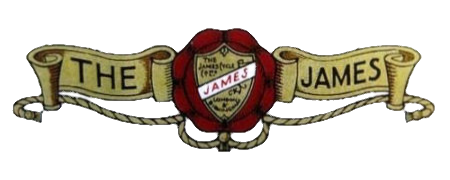



Additional comfort is provided on the 2½ h. p. James by a new type of flexible saddle suspension
James. (Stand 88.)
2½ h.p.; 66x70 mm. (239.5 c.c); single-cylinder two-stroke; drip feed lubrication; Amac carburetter; Thomson-Bennett chain-driven magneto; two-speed dogs and chain gear; chain and belt drive; 26x2¼ in. tyres. Price £75.
James Cycle Co., Ltd., Greet Birmingham.
A machine of high-class specification which possesses many refinements is the James 2¼ h.p. two-stroke. It is a true lightweight with 26in. wheels and tyres, and a riding position which is as low as it is comfortable, a specially adapted Lycett saddle with spring peak being fitted. Minor improvements have been carried out, and the engine has been slightly increased in size, as formerly it had a cubic capacity of 226 c.c.
Twin engines of 500 c.c. are nowadays rare, but the popularity of the 3½ h.p. twin James is little likely to suffer for that reason. As a solo machine it has the merit of lightness combined with power, and with large footboards and a comfortable riding position it is a mount which can be ridden a considerable distance in the day without causing a feeling of fatigue to the rider. The position of the magneto high up behind the rear cylinder ensures that it is protected from wet, and it is at the same time accessible.
The big single-cylinder James has been refined and brought up to date, so that it should continue to be a very popular sidecar machine. Apart from minor alterations, 28in. wheels and large domed mudguards are fitted. The latest gear control is a long lever pivoted to the crank case, working in a cast aluminium rack secured to the frame just underneath the tank. The clutch is controlled by a conveniently arranged heel pedal, although, if preferred, hand control or both may be fitted. The return spring of the kick-starter is enclosed and protected from mud and dust, a flat ribbon spring, similar to the main spring of a clock, being utilised. The half compression device has been improved in operation, the cable being abolished and replaced by a neat lever which can be brought into operation by the toe.
7 h.p.; 73x89.3 mm. (749 c.c); twin-cylinder four-stroke; side-by-side valves; drip feed lubrication; Amac carburetter; Thomson-Bennett chain-driven magneto; three-speed sliding gear; chain drive; 28x3in. tyres.
Considerable interest centres in the big twin James, as it is an entirely new model for 1921. A feature of the engine is the off-setting of the exhaust valves in relation to the inlet valves, a clear passage being left between the valve ports and the cylinders, resulting in very efficient cooling. Another advantage of this construction is that the valve rocker levers may be kept straight instead of being cranked. The valve springs and tappets are encased by quickly detachable i covers. A large roller bearing big end is employed, and the gudgeon pin is secured in the little end of the connecting rod. taking its bearings direct in the piston in bosses of ample dimension.
Apart from the usual oil lead to the crank case a separate lead is taken to each cylinder. The gear box has been redesigned and consists of a die casting with short rigid shafts and gears carried in Hoffmann bearings of large size. The rear wheel is quickly detachable, leaving the chain sprocket in situ. An expanding brake on car lines is fitted in a drum on the rear wheel. The sidecar connections have universal movement so that alignment is easily carried out.
Olympia Show. The Motor Cycle, December 2nd, 1920. Page 726